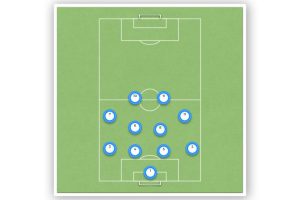Defend Like a Pro: Strategies to Counter High Pressing Soccer Tactics
As a soccer player, I know how frustrating it can be to play against a team that employs high pressing tactics. The constant pressure and swarming of players around the ball can make it difficult to maintain possession and create scoring opportunities. However, there are strategies and techniques that can be used to effectively defend against these tactics and gain an advantage on the field.
One key aspect of defending against high pressing tactics is to focus on maintaining possession of the ball. This means playing smart and making accurate passes to keep the ball away from the opposition. It also involves being aware of the positioning of the opposing players and making quick decisions to avoid being closed down.
Another important factor is to have a team that is well-drilled and organized in their defensive shape. This means knowing when to press and when to drop back, and being able to quickly transition from defense to attack. It also involves having a strong and cohesive midfield that can effectively control the tempo of the game and keep the ball moving forward.
Understanding High Pressing Tactics
What is High Pressing?
High pressing is a soccer tactic where a team applies intense pressure on the opposition team in their half of the field with the aim of winning the ball back quickly. This tactic involves players moving up the field to close down the opposition players and limit their time and space on the ball.
Why is High Pressing Effective?
High pressing is an effective tactic because it disrupts the opposition’s build-up play and forces them to make mistakes. By winning the ball back in the opposition’s half, teams can create scoring opportunities and control the game. Additionally, high pressing can demoralize the opposition team and limit their confidence on the ball.
Common High Pressing Strategies
There are several common strategies used in high pressing, such as the Gegenpress, which involves pressing immediately after losing possession, and the Cover Shadow Press, which involves positioning players to block passing lanes and limit the opposition’s options. Another strategy is the Counter Press, which involves pressing immediately after winning possession to prevent the opposition from counter-attacking.
How to Identify High Pressing Teams
High pressing teams tend to have a high defensive line, with players pushing up the field to reduce the amount of space the opposition has to play in. They also tend to have a high work rate, with players constantly pressing and closing down the opposition. Additionally, high pressing teams often use a zonal marking system, where players are responsible for marking an area of the field rather than a specific player.
The Risks of High Pressing
While high pressing can be an effective tactic, it also comes with risks. If a team is unable to win the ball back quickly, they can be left exposed at the back, which can lead to conceding goals. High pressing also requires a high level of fitness and discipline, as players need to maintain their intensity throughout the game. Additionally, high pressing can leave gaps in midfield, which can be exploited by the opposition team. Overall, high pressing is a tactic that requires careful planning and execution. While it can be an effective way to control the game and create scoring opportunities, it also comes with risks that need to be managed.
Read our article on the types of pressing.
Defending Against High Pressing Tactics
As a defender, I know that high pressing tactics can be difficult to defend against, but there are ways to counter them. In this section, I will discuss some strategies that can be used to defend against high pressing tactics.
Maintaining Possession and Playing Out from the Back
One way to defend against high pressing tactics is to maintain possession of the ball and play out from the back. This can be done by having a strong passing game and good ball control skills. By keeping the ball and passing it around, we can frustrate the opposition and force them to chase the ball, which can tire them out and create gaps in their defense.
It’s important to have players who are comfortable on the ball and can make quick, accurate passes under pressure. This requires good communication and teamwork, as well as a clear understanding of each player’s role on the field.
Exploiting Space Behind the Press
Another way to defend against high pressing tactics is to exploit the space behind the press. When the opposition pushes up to press us, they leave gaps in their defense that we can exploit with quick counter-attacks. This requires fast, skillful players who can make runs into space and take advantage of any openings.
It’s important to have players who can read the game and anticipate where the gaps will be. This requires good awareness and a clear understanding of the opposition’s tactics.
Counter-Attacking Opportunities
Defending against high pressing tactics also involves looking for counter-attacking opportunities. When the opposition commits too many players forward, they leave themselves vulnerable to quick counter-attacks. This requires players who are fast, skillful, and can finish well.
It’s important to have a clear plan for counter-attacks and to communicate effectively with teammates. This requires good teamwork and an understanding of each player’s strengths and weaknesses.
Individual Defensive Strategies
Defending against high pressing tactics also involves individual defensive strategies. This includes things like marking tightly, intercepting passes, and making tackles. It’s important to be aggressive and assertive in defense, but also to be disciplined and avoid giving away fouls or penalties.
It’s important to have players who are comfortable defending one-on-one and can read the game well. This requires good awareness, anticipation, and positioning.
Team Defensive Strategies
Finally, defending against high pressing tactics also involves team defensive strategies. This includes things like pressing as a unit, maintaining a good defensive shape, and communicating effectively. It’s important to work together as a team and to be organized and disciplined in defense.
It’s important to have players who are committed to defending as a team and who are willing to work hard for each other. This requires good teamwork, communication, and leadership.
Conclusion
Defending against high pressing tactics in soccer can be a challenging task. However, with the right strategies and techniques, it is possible to overcome the pressure and maintain possession of the ball. Throughout this article, I have discussed various methods that can be used to defend against high pressing soccer tactics.
Firstly, it is important to maintain a compact shape and limit the amount of space between the players. This can be achieved by playing a narrow formation and ensuring that the players stay close to each other. Additionally, players should be aware of their positioning and avoid getting caught out of position.
Secondly, quick passing and movement can be effective in breaking down high pressing tactics. By moving the ball quickly and making accurate passes, it is possible to create gaps in the opposition’s defense and create scoring opportunities.
Thirdly, players should be comfortable with playing under pressure and should be able to make quick decisions when in possession of the ball. This can be achieved through regular training drills that simulate high pressure situations.
Finally, it is important to remain calm and composed when under pressure. Players should not panic or rush their passes, as this can lead to mistakes and turnovers. Instead, they should remain patient and look for opportunities to play the ball forward.
By following these strategies and techniques, it is possible to defend against high pressing soccer tactics and maintain possession of the ball. With practice and dedication, players can become more comfortable and confident in dealing with high pressure situations, and ultimately become more successful on the field.






